Input interpretation

carbon (chemical element) | hydrogen (chemical element) | beryllium (chemical element)
Periodic table location

Periodic table location
Images
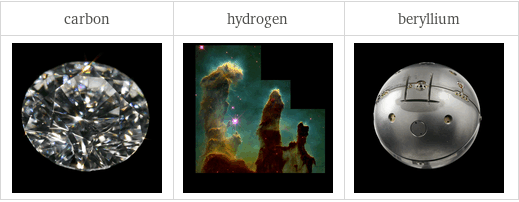
Images
Basic elemental properties
![| carbon | hydrogen | beryllium atomic symbol | C | H | Be atomic number | 6 | 1 | 4 short electronic configuration | [He]2s^22p^2 | 1s^1 | [He]2s^2 Aufbau diagram | 2p 2s | 1s | 2s block | p | s | s group | 14 | 1 | 2 period | 2 | 1 | 2 atomic mass | 12.011 u | 1.008 u | 9.0121831 u half-life | (stable) | (stable) | (stable)](../image_source/950af9f6c64beeb3ab9334155d0250b2.png)
| carbon | hydrogen | beryllium atomic symbol | C | H | Be atomic number | 6 | 1 | 4 short electronic configuration | [He]2s^22p^2 | 1s^1 | [He]2s^2 Aufbau diagram | 2p 2s | 1s | 2s block | p | s | s group | 14 | 1 | 2 period | 2 | 1 | 2 atomic mass | 12.011 u | 1.008 u | 9.0121831 u half-life | (stable) | (stable) | (stable)
Thermodynamic properties
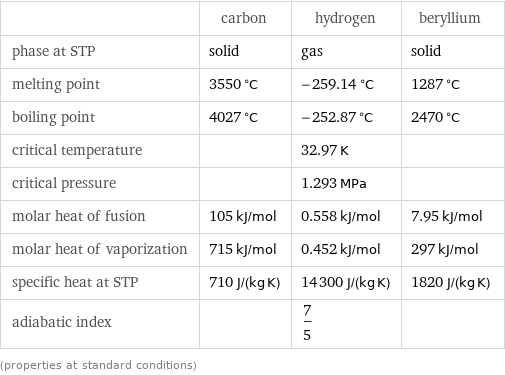
| carbon | hydrogen | beryllium phase at STP | solid | gas | solid melting point | 3550 °C | -259.14 °C | 1287 °C boiling point | 4027 °C | -252.87 °C | 2470 °C critical temperature | | 32.97 K | critical pressure | | 1.293 MPa | molar heat of fusion | 105 kJ/mol | 0.558 kJ/mol | 7.95 kJ/mol molar heat of vaporization | 715 kJ/mol | 0.452 kJ/mol | 297 kJ/mol specific heat at STP | 710 J/(kg K) | 14300 J/(kg K) | 1820 J/(kg K) adiabatic index | | 7/5 | (properties at standard conditions)
Material properties

| carbon | hydrogen | beryllium density | 2.26 g/cm^3 | 8.99×10^-5 g/cm^3 | 1.848 g/cm^3 liquid density | | | 1.69 g/cm^3 molar volume | 5.315 cm^3/mol | 11200 cm^3/mol | 4.877 cm^3/mol Mohs hardness | 0.5 (between talc and gypsum) | | 5.5 (between apatite and microcline) Vickers hardness | | | 1670 MPa Brinell hardness | | | 600 MPa bulk modulus | 33 GPa | | 130 GPa shear modulus | | | 132 GPa Young's modulus | | | 287 GPa Poisson ratio | | | 0.032 tensile yield strength | | | 240 MPa ultimate tensile strength | | | 370 MPa refractive index | 2.417 | 1.000132 | sound speed | 18350 m/s | 1270 m/s | 13000 m/s thermal expansion | 7.1×10^-6 K^(-1) | | 1.13×10^-5 K^(-1) thermal conductivity | 140 W/(m K) | 0.1805 W/(m K) | 190 W/(m K) (properties at standard conditions)
Electromagnetic properties
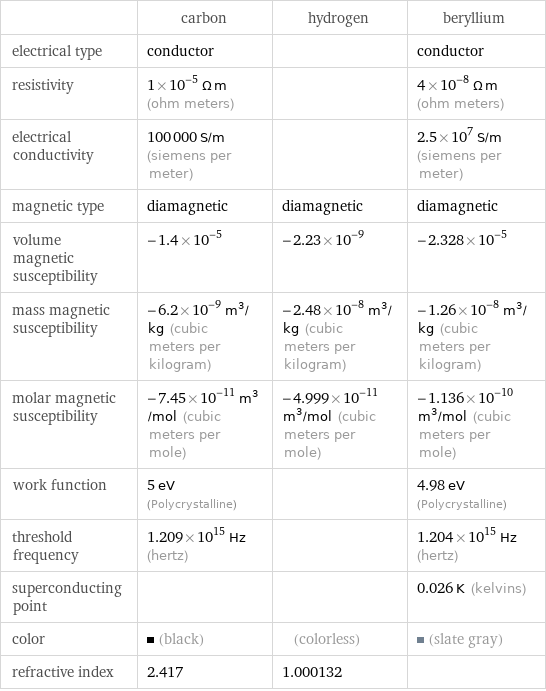
| carbon | hydrogen | beryllium electrical type | conductor | | conductor resistivity | 1×10^-5 Ω m (ohm meters) | | 4×10^-8 Ω m (ohm meters) electrical conductivity | 100000 S/m (siemens per meter) | | 2.5×10^7 S/m (siemens per meter) magnetic type | diamagnetic | diamagnetic | diamagnetic volume magnetic susceptibility | -1.4×10^-5 | -2.23×10^-9 | -2.328×10^-5 mass magnetic susceptibility | -6.2×10^-9 m^3/kg (cubic meters per kilogram) | -2.48×10^-8 m^3/kg (cubic meters per kilogram) | -1.26×10^-8 m^3/kg (cubic meters per kilogram) molar magnetic susceptibility | -7.45×10^-11 m^3/mol (cubic meters per mole) | -4.999×10^-11 m^3/mol (cubic meters per mole) | -1.136×10^-10 m^3/mol (cubic meters per mole) work function | 5 eV (Polycrystalline) | | 4.98 eV (Polycrystalline) threshold frequency | 1.209×10^15 Hz (hertz) | | 1.204×10^15 Hz (hertz) superconducting point | | | 0.026 K (kelvins) color | (black) | (colorless) | (slate gray) refractive index | 2.417 | 1.000132 |
Reactivity

| carbon | hydrogen | beryllium valence | 4 | 1 | 2 electronegativity | 2.55 | 2.2 | 1.57 electron affinity | 153.9 kJ/mol (kilojoules per mole) | 72.8 kJ/mol (kilojoules per mole) | 0 kJ/mol (kilojoules per mole) first ionization energy | 1086.5 kJ/mol (kilojoules per mole) | 1312 kJ/mol (kilojoules per mole) | 899.5 kJ/mol (kilojoules per mole) ionization energies | 1086.5 kJ/mol | 2352.6 kJ/mol | 4620.5 kJ/mol | 6222.7 kJ/mol | 37831 kJ/mol | 47277 kJ/mol | 1312 kJ/mol | 899.5 kJ/mol | 1757.1 kJ/mol | 14848.7 kJ/mol | 21006.6 kJ/mol
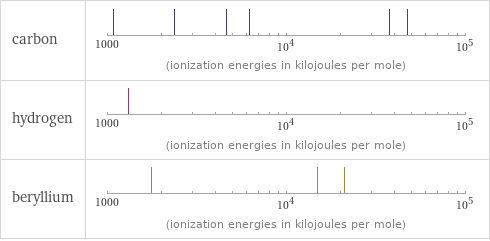
Reactivity
Atomic properties
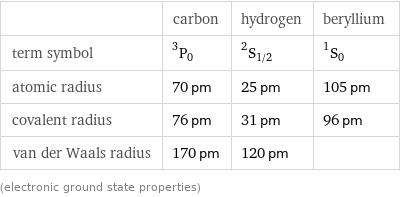
| carbon | hydrogen | beryllium term symbol | ^3P_0 | ^2S_(1/2) | ^1S_0 atomic radius | 70 pm | 25 pm | 105 pm covalent radius | 76 pm | 31 pm | 96 pm van der Waals radius | 170 pm | 120 pm | (electronic ground state properties)
Abundances

| carbon | hydrogen | beryllium universe abundance | 0.5 mass% | 75 mass% | 1×10^-7 mass% solar abundance | 0.3 mass% | 75 mass% | 1×10^-8 mass% meteorite abundance | 1.5 mass% | 2.4 mass% | 2.9×10^-6 mass% crust abundance | 0.18 mass% | 0.15 mass% | 1.9×10^-4 mass% ocean abundance | 0.0028 mass% | 11 mass% | 6×10^-11 mass% human abundance | 23 mass% | 10 mass% | 4×10^-8 mass% universe molar abundance | 0.05 mol% | 93 mol% | 1×10^-8 mol% solar molar abundance | 0.03 mol% | 93 mol% | 9.9×10^-10 mol% meteorite molar abundance | 1.8 mol% | 17 mol% | 7×10^-6 mol% ocean molar abundance | 0.0014 mol% | 66 mol% | 4.1×10^-11 mol% crust molar abundance | 0.31 mol% | 3.1 mol% | 4.3×10^-4 mol% human molar abundance | 12 mol% | 62 mol% | 3×10^-8 mol%
Nuclear properties
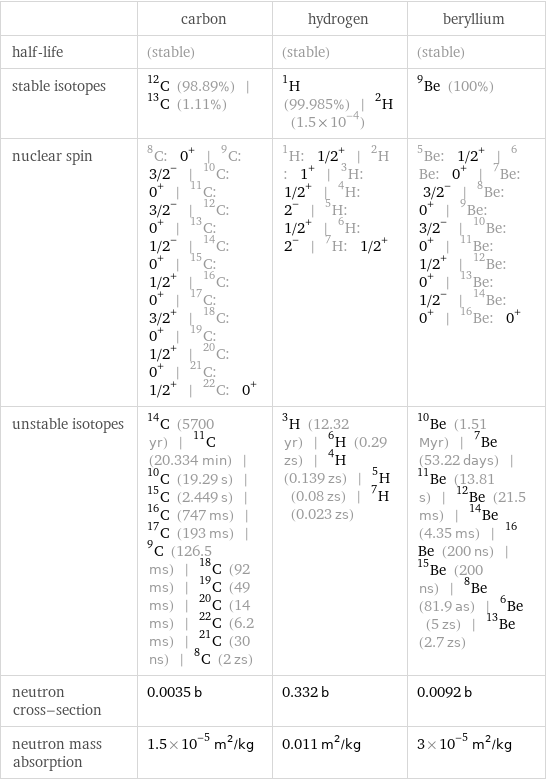
| carbon | hydrogen | beryllium half-life | (stable) | (stable) | (stable) stable isotopes | C-12 (98.89%) | C-13 (1.11%) | H-1 (99.985%) | H-2 (1.5×10^-4) | Be-9 (100%) nuclear spin | C-8: 0^+ | C-9: 3/2^- | C-10: 0^+ | C-11: 3/2^- | C-12: 0^+ | C-13: 1/2^- | C-14: 0^+ | C-15: 1/2^+ | C-16: 0^+ | C-17: 3/2^+ | C-18: 0^+ | C-19: 1/2^+ | C-20: 0^+ | C-21: 1/2^+ | C-22: 0^+ | H-1: 1/2^+ | H-2: 1^+ | H-3: 1/2^+ | H-4: 2^- | H-5: 1/2^+ | H-6: 2^- | H-7: 1/2^+ | Be-5: 1/2^+ | Be-6: 0^+ | Be-7: 3/2^- | Be-8: 0^+ | Be-9: 3/2^- | Be-10: 0^+ | Be-11: 1/2^+ | Be-12: 0^+ | Be-13: 1/2^- | Be-14: 0^+ | Be-16: 0^+ unstable isotopes | C-14 (5700 yr) | C-11 (20.334 min) | C-10 (19.29 s) | C-15 (2.449 s) | C-16 (747 ms) | C-17 (193 ms) | C-9 (126.5 ms) | C-18 (92 ms) | C-19 (49 ms) | C-20 (14 ms) | C-22 (6.2 ms) | C-21 (30 ns) | C-8 (2 zs) | H-3 (12.32 yr) | H-6 (0.29 zs) | H-4 (0.139 zs) | H-5 (0.08 zs) | H-7 (0.023 zs) | Be-10 (1.51 Myr) | Be-7 (53.22 days) | Be-11 (13.81 s) | Be-12 (21.5 ms) | Be-14 (4.35 ms) | Be-16 (200 ns) | Be-15 (200 ns) | Be-8 (81.9 as) | Be-6 (5 zs) | Be-13 (2.7 zs) neutron cross-section | 0.0035 b | 0.332 b | 0.0092 b neutron mass absorption | 1.5×10^-5 m^2/kg | 0.011 m^2/kg | 3×10^-5 m^2/kg
Identifiers

| carbon | hydrogen | beryllium CAS number | 7440-44-0 | 1333-74-0 | 7440-41-7 PubChem CID number | | 783 | 5460467